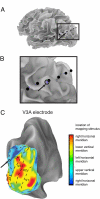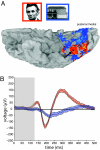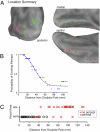Perceiving electrical stimulation of identified human visual areas
- PMID: 19276119
- PMCID: PMC2664020
- DOI: 10.1073/pnas.0804998106
Perceiving electrical stimulation of identified human visual areas
Abstract
We studied whether detectable percepts could be produced by electrical stimulation of intracranial electrodes placed over human visual areas identified with fMRI. Identification of areas was confirmed by recording local-field potentials from the electrode, such as face-selective electrical responses from electrodes over the fusiform face area (FFA). The probability of detecting electrical stimulation of a visual area varied with the position of the area in the visual cortical hierarchy. Stimulation of early visual areas including V1, V2, and V3 was almost always detected, whereas stimulation of late visual areas such as FFA was rarely detected. When percepts were elicited from late areas, subjects reported that they were simple shapes and colors, similar to the descriptions of percepts from early areas. There were no reports of elaborate percepts, such as faces, even in areas like FFA, where neurons have complex response properties. For sites eliciting percepts, the detection threshold was determined by varying the stimulation current as subjects performed a forced-choice detection task. Current thresholds were similar for late and early areas. The similarity between both percept quality and threshold across early and late areas suggests the presence of functional microcircuits that link electrical stimulation with perception.
Conflict of interest statement
The authors declare no conflict of interest.
Figures




References
-
- Britten KH, van Wezel RJ. Electrical microstimulation of cortical area MST biases heading perception in monkeys. Nat Neurosci. 1998;1:59–63. - PubMed
-
- Afraz SR, Kiani R, Esteky H. Microstimulation of inferotemporal cortex influences face categorization. Nature. 2006;442:692–695. - PubMed
-
- Penfield WR, Rasmussen T. The Cerebral Cortex of Man: A Clinical Study of Localization of Function. New York: Macmillan; 1957.
Publication types
MeSH terms
Grants and funding
LinkOut - more resources
Full Text Sources
Other Literature Sources

